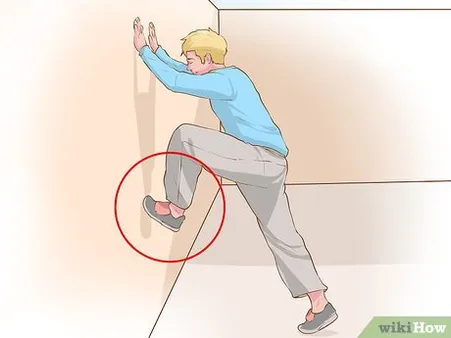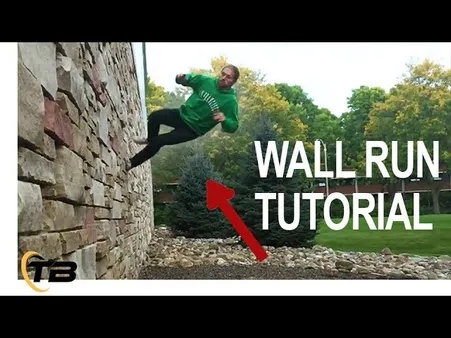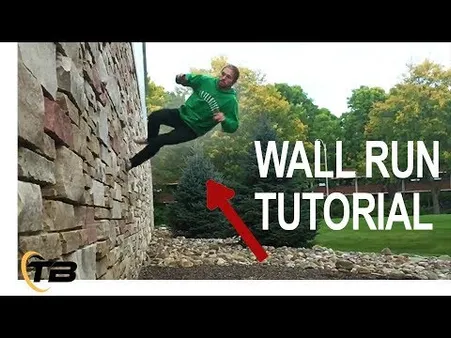Table of Contents
Welcome to the world of wall running, where gravity is your playground and walls are your canvas. Kizworld presents a comprehensive guide to mastering this exhilarating movement, unlocking the secrets of How to do a wall run like a pro. Whether you're a seasoned parkour athlete or just starting your journey, this guide will equip you with the knowledge and skills to conquer walls with grace and precision. Get ready to defy gravity, explore new dimensions of movement, and experience the thrill of wall running like never before.
How to do a wall run: A step-by-step guide for beginners
I. Essential Techniques: Breaking Down the Wall Run
For a successful wall run, mastering proper technique is paramount. Begin by adopting an athletic stance with your feet shoulder-width apart. Position yourself at a slight angle to the wall, ensuring your dominant foot is closer to it. Bend your knees and engage your core for stability, keeping your back straight.
- With controlled force, push off the ground, propelling yourself toward the wall.
- Upon reaching the wall, swiftly plant your dominant foot against it just above your waist level. Simultaneously, bring your non-dominant leg forward, extending it along the wall.
- Exert pressure on your planted foot while simultaneously pushing off the wall with your extended leg, generating upward momentum.
- As you ascend, bring your non-dominant leg towards your chest, and then swiftly extend it forward along the wall, continuing the upward movement.
II. Putting It All Together: Execution and Common Mistakes
Executing a wall run seamlessly requires a combination of technique, balance, and practice. As you climb higher, switch the position of your legs, alternating between your dominant and non-dominant foot. To effectively complete the wall run, extend your body parallel to the wall, maintaining a controlled descent by gradually transferring your weight as you lower yourself.
Avoiding common mistakes during a wall run is crucial for a safe and successful performance. A prevalent error is placing your feet too high or too low on the wall, causing loss of balance. Additionally, using excessive force can lead to injury, so it's essential to control your momentum. Initiate your wall run with a moderate speed, gradually increasing it as you gain confidence and experience.
Mistakes | Reasons |
|---|---|
Feet placed too high on the wall | Inadequate reach and increased risk of falling |
Feet placed too low on the wall | Insufficient height gained and potential for stumbling |
Excessive force exerted | Increased risk of injury and diminished control |
III. Perfect a Backflip
Perfect a Backflip
Mastering a backflip is a thrilling milestone in the journey of any aspiring traceur. This gravity-defying move requires a combination of strength, agility, and impeccable timing. To execute a flawless backflip, follow these steps:
- Start with a Solid Foundation: Before attempting a backflip, ensure you have a strong command of basic parkour skills, including proper landing techniques and the ability to perform a front flip.
- Choose the Right Environment: Select a safe and open area with a soft landing surface, such as a gymnastic mat or a grassy field.
Step-by-Step Guide to a Backflip:
- Prepare for Takeoff: Begin by standing with your feet shoulder-width apart, knees slightly bent, and arms extended in front of you.
- Generate Momentum: Take a few quick steps forward to build momentum, then jump vertically into the air, reaching your arms overhead.
- Tuck and Flip: As you reach the apex of your jump, tuck your knees into your chest and bring your arms down to your sides. Simultaneously, arch your back and push your hips forward to initiate the flip.
- Spot Your Landing: During the flip, keep your eyes focused on a fixed point on the ground where you intend to land. This will help you maintain your balance and control.
- Extend and Land: As you approach the ground, extend your legs and arms to absorb the impact. Land softly on the balls of your feet, bending your knees to cushion the landing.
Practice Makes Perfect:
- Start Small: Begin by practicing backflips from a lower height, such as a curb or a low wall, before gradually increasing the height as you gain confidence.
- Focus on Technique: Pay attention to your form and technique throughout the flip. Ensure you are tucking your knees tightly, arching your back, and spotting your landing correctly.
- Train Regularly: Consistent practice is key to mastering the backflip. Dedicate time each week to work on your technique and build the necessary strength and agility.
Safety First:
- Always Warm Up: Before attempting a backflip, warm up your body with dynamic stretches and light exercises to reduce the risk of injury.
- Use Spotters: When practicing backflips, have a spotter or a partner assist you to ensure your safety and provide feedback on your technique.
- Listen to Your Body: If you feel pain or discomfort during any stage of the backflip, stop immediately and consult a medical professional if necessary.
With dedication, practice, and a focus on safety, you can conquer the backflip and add this impressive move to your parkour repertoire. Remember, patience and perseverance are key to achieving your parkour goals.
| How to Do a Handstand | How to Do a Cartwheel | How to Do a Front Flip |
| How to Do a Roundoff | How to Do a Walkover | How to Do a Somersault |
| How to Do a Split | How to Do a Breakfall | How to Do a Sparring |
IV. Learn the Basic Wall Run Motion
Learn the Basic Wall Run Motion
Executing a proper wall run motion forms the foundation for this captivating movement. Kickstart your journey with the essential techniques that will propel you towards traversing walls like a true Traceur.
Initiate the wall run by positioning your body close to the wall, with your dominant foot slightly forward and your body angled at approximately 45 degrees. Maintaining this angle, drive your non-dominant leg forcefully against the wall, propelling yourself upwards and sideways. Simultaneously, engage your dominant leg by bringing it up onto the wall, using it for balance and stability.
- Engage Core Muscles for Stability
- Plant Non-Dominant Foot Firmly
- Drive Dominant Leg with Power
Once you are airborne, ensure your weight is centered over your supporting leg while keeping your other leg extended. This creates a stable base for you to maintain your balance as you navigate the wall.
As you land on the wall, absorb the impact using your legs and arms, distributing the force evenly to reduce injury risk. Quickly transition into a forward motion by pushing off the wall with your dominant leg and swinging your non-dominant leg forward, akin to a sprinter leaving the starting blocks.
Starting Position | Wall Engagement | Ascent and Balance | Landing and Forward Momentum |
Body close to wall, 45-degree angle | Drive non-dominant leg, bring up dominant leg | Center weight over supporting leg | Absorb impact, push off with dominant leg |
V. Beyond the Basic: Refined Techniques for Seamless Movement
Once you have mastered the fundamental wall run motion, explore advanced techniques to further enhance your agility, control, and fluidity. Discover how seasoned Traceurs elevate their wall running skills to perform spectacular maneuvers with grace and precision.
Master the "Cat Leap" to seamlessly transition from one wall to another, defying gravity with a swift, fluid motion. This technique requires impeccable timing and coordination, demonstrating your prowess as a skilled Traceur.
- Related Post: The Cat Leap: A Boundless Leap into the Art of Parkour
Incorporate the "Reverse Wall Run" to surprise your audience with a sudden shift in direction, leaving them awe-inspired. This technique, akin to a dance move on a vertical plane, showcases your agility and adaptability in the urban playground.
VI. Mastering the Art of Wall Runs: A Comprehensive Guide
VII. Prerequisites for Wall Running: Gear, Safety, and Skills
VIII. Essential Techniques: Breaking Down the Wall Run
IX. Putting It All Together: Execution and Common Mistakes
X. Additional Tips: Enhancing Your Performance
XI. Variations and Challenges: Taking Wall Runs to the Next Level
XII. Key Points - How to Do a Wall Run
XIII. Apply for Higher Walls
Apply for Higher Walls
Attaining the proficiency to take on higher walls is a gradual process that calls for unwavering commitment and persistence. Patience and resilience are crucial virtues to possess during this time, as progress may not come as swiftly as desired.
A vital initial step involves strengthening your legs. This can be achieved through exercises including squats, lunges, and calf raises. By focusing on these exercises, you lay the foundation for generating the necessary power required for effective wall runs.
Exercise | Description | Sets and Repetitions |
Squats | Lower your body by bending your knees and hips, as if sitting back into a chair. Keep your back straight and ensure your knees do not extend past your toes. | 3 sets of 8-12 repetitions |
Lunges | With one leg forward and the other back, lower your body by bending both knees. Keep your front knee aligned above your ankle and your back knee close to the ground. | 3 sets of 8-12 repetitions per leg |
Calf Raises | Stand with your feet shoulder-width apart and slowly raise your heels until you feel a stretch in your calves. Hold this position for a few seconds before lowering your heels back down. | 3 sets of 15-20 repetitions |
Apart from leg strength, honing your overall body control is equally important. Engage in exercises such as push-ups, pull-ups, and core work to cultivate a strong and agile physique.
Developing a solid foundation in foundational parkour techniques is pivotal. This includes mastering the skills of jumping, landing, and basic vaults. Familiarity with these techniques will serve as the cornerstone for transitioning into wall runs.
- Precision Jumps: Focus on controlling your body and maintaining balance while clearing obstacles with precision.
- Cat Leaps: Learn to transfer your momentum effectively while jumping over obstacles, maintaining a fluid and agile motion.
- Kong Vaults: Master the technique of vaulting over obstacles using both hands, emphasizing proper form and the generation of momentum.
With unwavering dedication and consistent practice, you will progress from conquering lower walls to tackling greater heights. Remember that safety remains paramount, so never attempt wall runs beyond your current skill level.
XIV. Apply for Higher Walls
As you progress on your wall running journey, it's natural to seek out higher challenges. While this is an exciting aspect of the sport, it's crucial to approach this pursuit with the utmost caution and preparation.
Before attempting higher walls, ensure you possess a solid foundation in the fundamental skills and techniques. A firm grasp of basic wall running techniques, including approach, take-off, and landing, is essential. Additionally, you must have mastered the art of parkour basics such as vaults, climbs, and rolls.
Skill/Technique | Level of Proficiency |
Basic Wall Running Techniques | Proficient in approach, take-off, and landing |
Parkour Basics | Strong command of vaults, climbs, and rolls |
Leg Strength | Ability to perform explosive jumps and maintain stability on landings |
Body Control | Excellent balance and coordination during movements |
Risk Assessment and Safety Awareness | Understanding of potential risks and adherence to safety protocols |
Once you're confident in your abilities, start by gradually increasing the height of the walls you attempt. Begin with walls that are slightly higher than your previous comfort zone, and work your way up progressively.
It's important to note that tackling higher walls requires not only physical prowess but also mental strength. The fear of heights is a common obstacle, and overcoming it is a crucial step in your journey as a wall runner.
- Confronting Fear of Heights: Develop strategies for managing and overcoming your fear, enabling you to push your limits and embrace the challenge.
- Prioritizing Safety: Familiarize yourself with safety guidelines and techniques for wall running, ensuring you take the necessary precautions to minimize risks.
- Selecting Appropriate Locations: Choose locations with suitable surfaces, adequate space, and minimal hazards to create an optimal environment for your wall running endeavors.
With unwavering dedication and a commitment to safety, you can conquer higher walls and achieve new heights in your wall running pursuits.
XV. Conclusion
As you embark on your wall running journey, remember that practice and perseverance are key. Start with smaller walls and gradually work your way up to more challenging heights. Prioritize safety by wearing appropriate gear and choosing suitable locations. Embrace the learning process, and don't be discouraged by setbacks. With dedication and a positive mindset, you'll master the art of wall runs and unlock a new dimension of movement. Wall running is not just a physical skill; it's an expression of creativity, freedom, and the human spirit's ability to overcome obstacles. Embrace the challenge, push your limits, and experience the exhilaration of conquering walls like never before.